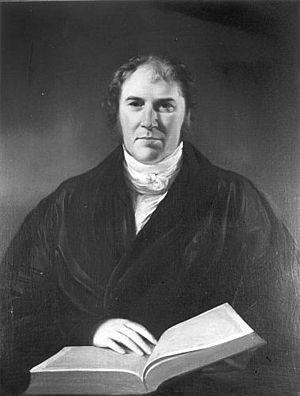Robert Adrain facts for kids
Quick facts for kids
Robert Adrain
|
|
|---|---|

portrait by Charles C. Ingham
|
|
| Born | 30 September 1775 Carrickfergus, County Antrim, Ireland
|
| Died | 10 August 1843 (aged 67) New Brunswick, New Jersey, US
|
| Known for | Least squares method |
| Scientific career | |
| Fields | Diophantine algebra Statistics |
| Institutions | Queen's College/Rutgers Columbia College University of Pennsylvania |
Robert Adrain (born September 30, 1775 – died August 10, 1843) was an Irish mathematician. He became very famous in the United States. He left Ireland after being involved in a rebellion in 1798. He then settled in New Jersey and Pennsylvania.
Robert Adrain was one of the first people to publish new math ideas in America. He shared this honor with Nathaniel Bowditch. Adrain is best known for developing the 'method of least squares.' This was a way to solve problems in surveying, like measuring land. He also studied physics, astronomy, and geodesy (the science of measuring the Earth). He was very interested in the shape of the Earth.
Contents
Robert Adrain's Early Life
Robert Adrain was born in Carrickfergus, County Antrim, Ireland. His father was a school teacher. He also made tools for math. Robert got a good education until he was fifteen. Sadly, both his parents died when he was young.
After their deaths, Robert supported himself and his four brothers and sisters. He took over his father's job as a teacher. He also worked as a private tutor.
Robert Adrain and the Rebellion
On June 7, 1798, Robert Adrain was part of a group called the Society of United Irishmen. He led some of these people in a fight. This was during the Irish Rebellion of 1798. In a battle against British forces, he was badly hurt.
After he got better, he had to leave Ireland. There was a reward offered for his capture. He, his wife, and their baby moved safely to America.
Robert Adrain's Math Career
Robert Adrain mostly taught himself math. Even so, he got a teaching job. This was at an academy in Princeton, New Jersey. In 1801, he became the head of the York County Academy in York, Pennsylvania.
He wrote for the Mathematical Correspondent. This was the first math magazine in the United States. He wrote the first article published in America about a type of math called diophantine algebra.
Later, he tried to start his own math magazine. It was called The Analyst, or, Mathematical Museum. He tried in 1808 and again in 1814. He didn't get enough people to subscribe. But the first issue of The Analyst was still very important. It was seen as "the best collection of mathematical work produced in the United States up to that time." Other famous mathematicians also wrote for it.
Robert Adrain's University Roles
In 1809, Robert Adrain became a professor at Rutgers University. It was called Queen's College back then. In 1810, Rutgers gave him an honorary M.A. degree.
In 1812, he became a member of the American Philosophical Society. The next year, he joined Columbia University. He also became a member of the American Academy of Arts and Sciences. From 1827, he was a Professor of Mathematics at the University of Pennsylvania.
In 1825, Robert Adrain started another magazine. It was called The Mathematical Diary. This one was more successful. It was published until 1832. It was for people who liked solving math problems.
Later Life and Legacy
In 1834, Robert Adrain left the University of Pennsylvania. He returned to New Brunswick, New Jersey. He rented a school room and taught private lessons until 1836. Then he went back to New York. He taught at the Columbia College Grammar School. In 1840, he retired to New Brunswick, where he passed away three years later.
Today, Robert Adrain would be called an applied mathematician. This means he used math to solve real-world problems. He believed that the best part of math was using it to understand nature. He was very interested in how math could explain the shape of the Earth.
Robert Adrain was the father of Garnett B. Adrain, who became a Congressman. A special blue sign honors Robert Adrain in Carrickfergus, Ireland.

